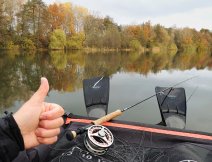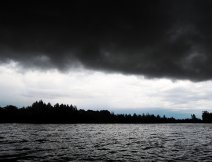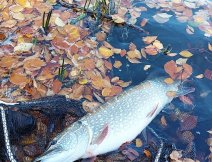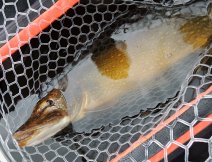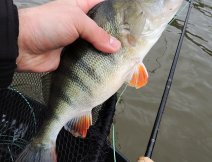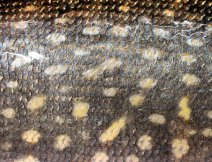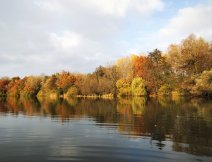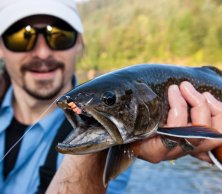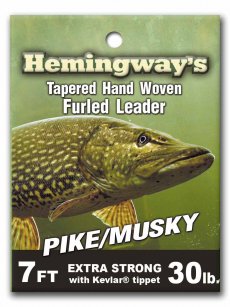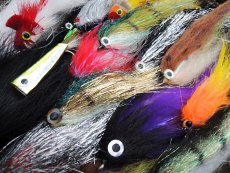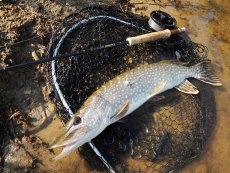If you want to be as successful as possible when fishing for pike on the fly, you should know and, most importantly, use all the right fishing tactics and fly fishing techniques, which go hand in hand with pike life and eating habits! Don't miss this next FLY FISHING SPECIAL and be 100% determined and ready to catch one of our most beautiful predatory fish - freshwater pike!
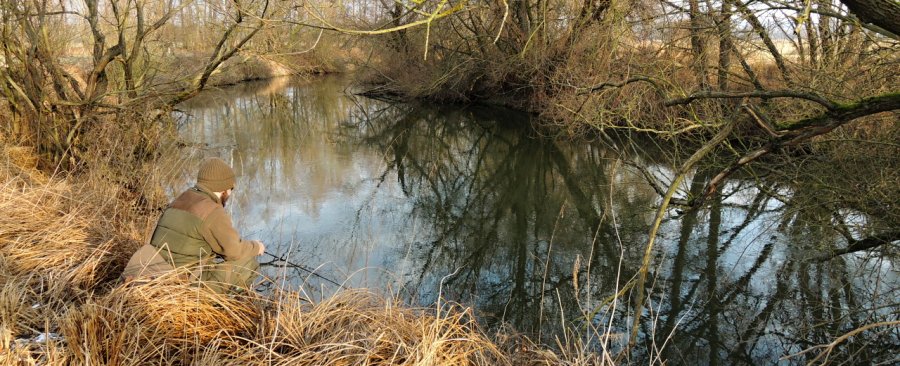
Freshwater Pike (Esox Lucius) is a really beautiful freshwater fish - and thanks to its arrow-shaped body, which is associated with the ability to "shoot" and attack prey, excellent eyesight and a huge mouth full of very sharp teeth - is one of our most active, most aggressive and the largest predatory fish, which we can catch very successfully and purposefully with the help of fly fishing equipment!
And even though it is still (especially in our fly fishing culture, which is now largely dominated by the "fanaticism" of modern nymphing) a kind of "fly fishing alternative" to the traditional fishing of river salmonids and possibly even small coarse fish, it seems to me - from my personal survey and monitoring of contributions in various fly fishing groups on social medias - that the interest in targeted pike fishing on the fly is relatively growing! Of course, it is always a question of how long an individual's interest in hunting will last, because fly fishing for pike and all predatory fish in general is not always as satisfactory/effective as other and more traditional fly fishing techniques for other and more "grateful" groups of fish.
In my opinion, a fly fisherman focused on catching predatory fish must be a determined and purposeful person with the spirit of a real hunter, whose first failure (or even a few failures in a row) does not immediately discourage and return to trout, grayling and chub fishing with French nymph leader, etc., but on the contrary rather motivates for other expeditions. If you consider yourself such a determined hunter, when fishing for pike/predatory fish you will need to be patient and persistent when using heavier fly fishing equipment, casting with larger flies than you are used to, and be ability to going trough difficult water or coastal terrain, to withstand harsh windy, rainy or snowy weather and - in case of real success - you will have to physically and especially mentally manage a possible fight with a trophy fish, or on the contrary to cope with its loss. The requirements are not simple, but believe me it is worth it! 😉
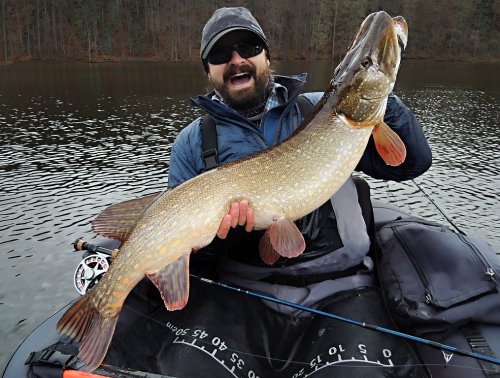
THE RIGHT FISHING/HUNTING TACTICS: If we are talking about the right tactics for fly fishing for pike, I would like to take this topic in an original form of good tips and useful recommendations that you should follow on the water - both in the case of searching for predators (their expected occurrence) and during their actual fishing, with which, of course, the pike fishing techniques themselves are closely connected, and which can then be relatively well classified according to the period of the fishing season (summer, autumn - winter), in which you will want to hunt pike most often!
From a general point of view, when fishing for pike and other predatory fish, it is very important to blend in with the nature in which you will be fishing! When fishing for predators, you can't be noisy and outspoken to hunting. Pike (as well as perch) often stand near the bank, so if you are going to fish from it, you should move around it deftly and quietly, because every major stomping (eg higher river bank above a promising pool) or sliding stones below with your feet (frequent terrain on valley dams) scares the fish and "shifts" from the shores for a while to the safety of deeper water! The same goes for your hunting clothes or the shadow falling on the coastal surface - pike often attack the bait close to the shore, so if you are dressed in something that does not fit very well into the surrounding nature, or your shadow falls exactly where you strip your streamer to to the tip of the rod, the pike will definitely change his mind about it!
If you have successfully resolved the issue of your "hunting invisibility", you must start looking for fish and ideally catch them effectively! In my opinion, it is always important to know what you are going to do - in other words: to have at least some awareness of where and how you will fish and depending on how big a river or reservoir you want to catch, you should plan the intensity of the hunt itself! I will simplify this into 2 types of approach, which I practice most often myself - both can be very effective in correctly evaluating the situation and estimating / reading the given nature of water.
* Qualitative way of endurance - Ideal especially for fishing from the bank on dams or slow-moving rivers of the channel type - with a monotonous course of the seemingly straight shore from which you fish. In this style of fishing, it is always best from my personal experience to define a relevant fishing section that you trust (either you already know it or it looks promising to you - often a question of intuition in places where you have not fished yet) and to capture it intensively and persistently by slow walking along the shore and fan-shaped casting the area of the underwater break of the shore and get the most out of every possible inequality you encounter - the same goes for systematic fishing in the opposite direction from water to shore (Belly Boat). In such places, pike often stand most of the season, whether it is a river bed or underwater bank breaks in still waters, because precisely in such places there is also their prey - small fish such as roaches, bream, perch, etc.
* Quantitative way of efficiency - A great tactic in situation, where you want to effectively fish-explore as many promising sections as possible, for example on a strongly meandering river, or try your luck only where you feel hope for a catch and do not stay longer than you think necessary! It is better to go this way of hunting if the area is more divided and you can estimate quite well where the fish can be, and where their occurrence is probably not threatened - as I wrote: deep meanders on the river, which alternate with shallow crossings, dams or flooded sandpits, where there are, for example, beautiful underwater breaks and inequalities and attractive bays, and on the other hand long and open shoals, where fishing would be a waste of time for most of the day.
❗ But given that our coarse rivers (except those with a symmetrical canal character) and dams/sandpits with pike, perch and zander are usually very diverse and very varied in terms of underwater and coastal fragmentation, you will certainly recognize that the ideal the solution will be a combination of both of the above-mentioned hunting approaches - a combination of perseverance and will together with experience, ingenuity and intuition/fishing talent.
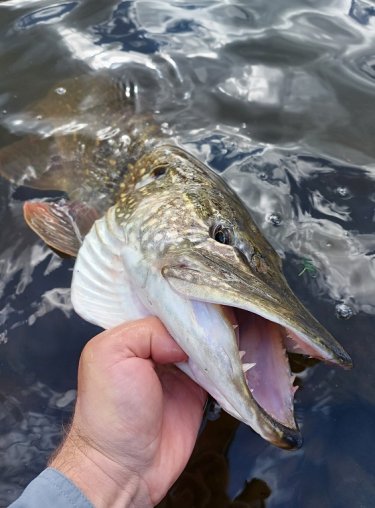
OCCURENCE OF PREDATORY FISH: As I mentioned, pike and, of course, other predators can be found wherever their most accessible prey is - small fish! So look for shoals of small fish and hunt near them, ideally there will be a predator somewhere within reach, which is either already actively hunting, or just waiting for a snack time - in which case you can still irritate it to capture with your repeatedly cast bait! Shoals of small fish are most often found near some underwater obstacles (branches, fallen trees, aquatic plants, large rocks, etc.), which provide them with possible shelter from danger, as well as, of course, at the breaks of shallow and deep water or current and deeper pool! Sometimes you can come across them in completely calm river water in the shade under the overhanging bank and branches of trees or bushes. And where the predator's prey is, sooner or later there must be the predator itself! 👌
It is generally known that really big pike no longer live near the shore and are more in open deep water - in such a situation, the tactics/technique of Fly Fishing From A Belly-Boat in a possible combination of reading mysterious depths with the help of an echo sounder, which will help you will allow you to orientate yourself in questions of suitable depth, underwater faults and obstacles or the occurrence of larger schools of fish - a combination of all these data can help you get closer to catching really large specimens, which you will encounter only very rarely from the shore. However, I never used echo sounders myself when fishing, so far I have relied only on the rich experience, perseverance, intuition and magic of the unpredictable arrival of that fishing luck, which for me still remains a very important symbol capturing the true beauty and hidden essence of fishing! 🙂
PIKE FLY FISHING TECHNIQUES: When fishing for pike by fly fishing, there is only one main fishing technique, which is primarily based on the eating habits of this beautiful freshwater predatory fish, namely streamer fishing - in other words - fishing for larger and large baits imitating the most common pike prey and other freshwater predators. As I wrote above, these most common prey are mainly small fish, then frogs, mice and small waterfowl, which we do not normally imitate with pike streamers. I deal with specific types of streamers intended for pike fishing in more detail in the following article "Flies & Gear For Pike Fly Fishing" (soon to be read), which you should definitely not miss!
In view of the above, I would therefore divide pike fishing by fly fishing - from the point of view of the most used streaming techniques, equipment and flies conditioned by it - into SUMMER (from 16 June - max. end of September) and AUTUMN/WINTER (October - December). Note: In The Czech Republic is fishing season for predatory fish from 16 June - 31 December).
SUMMER PIKE FLY FISHING: In summer pike fishing are particularly effective and so typical for this period surface and subsurface lures such as Popper, Gurgler or Diver imitating wounded fish and amphibians or mice guided on a floating or subsurface hover fly line. Pike, or even large perch, which have similar hunting habits in this regard, inhabit warm and overgrown shoals full of small fish, especially in the early morning and evening, and can therefore be very well provoked to catch an aggressively retrieved surface streamer that makes it on the surface a loud commotion accompanied by pressure waves and bubbles, which hungry pike - as an uncompromising predator - certainly can not leave unnoticed!
If you want to enjoy breathtaking adrenaline hunts, cast your floating streamer into shallow overgrown areas (river rivers, dam bays or flooded songs) and immediately after the impact, start aggressively retrieving with irregular stops = Stop & Go. It is at such moments that very often significant strikes come calmly even from large pike, which go out to hunt even in shallow waters. This fishing technique is really exciting, but they are always so effective in terms of the number of fish caught, because pike in their zeal often do not have to hit the bait even several times, or get rid of a badly swallowed stream in dense underwater vegetation. Anyway, it's an amazing style of hunting that you must try, because in this case, the journey is the goal!
The advantage of summer fly fishing for pike is that we do not have to look deep for pike, for example when fishing with intermediate lines, because it all depends on the occurrence of small fish, which can be found mainly in the upper floors of the water column, the disadvantage is early morning rising, because if the weather is not bad (wet and colder days), on typical hot summer days you have hope for a more decent pike, especially in the early morning!
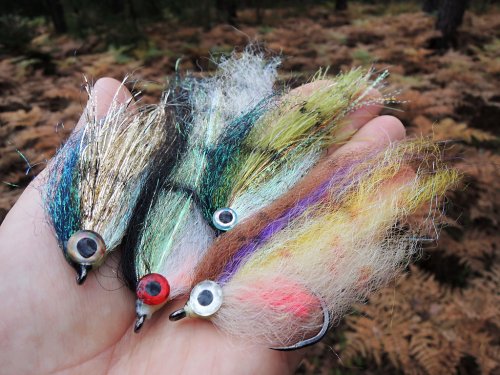
AUTUMN/WINTER PIKE FLY FISHING: As the water cools, the predator's prey moves to the lower floors of the water column and thus also the predators themselves move. At the beginning of autumn, you can still do with a floating or intermediate fly line, and especially in the beautiful days of Indian summer, there is still hope for catching nice pike in shallower water. With more cooling, you will have to gradually switch to faster intermediate and slow sinking fly lines. It will definitely be necessary to replace surface streamers with traditional fish streamers, which slowly sink, fall on the head and imitate injured fish, which pike like to relieve their suffering! I myself like to fish with a fast intermid or sinking fly line S3 - S6 according to the speed of the streamer retrieving and, for example, the size of the waves on stagnant water - the autumn months are often very windy and in such cases you have to use faster lines to not pull the streamer just below the surface in the time when you want to fish, for example, at a depth of 2-3 meters! Try the move of larger fish streamers first in the water under the rod to know how your bait works best - whether with shorter, sharp and faster pulls, or with long and slower pulses, which I personally like best - depending on the style of movement of your pike streamers and I design.
When fishing with fast intermediate and sinking fly lines, do not overdo it with long casts "behund the fish ". Of course, you can occasionally attract pike from longer distances, but you are more at risk of getting stuck with your streamer, which is not something you would want to solve at the expense of fishing on a short and cold autumn or winter day in the stony underwater slope of the dam!
➡ FLIES & GEAR FOR PIKE FLY FISHING
⭐ If you are really interested in the topic of pike fly fishing, be sure not to miss this other related article from my FLY FISHING SPECIAL, which this time is dedicated to fishing this beautiful freshwater predator! Then all you have to do is combine the loaded information from these articles together with your determination to catch the first big pike + subsequent personal experience and believe me, if you go against it, you will soon start to prosper!
I wish you a pleasant and informative reading and during the fishing a lot of perseverance, hunting will and finally valuable catches of beautiful big pike inhabiting our beautiful coarse rivers, valley dams, ponds but also the mysterious depths of flooded sandpits! Tight lines, Aleš 🎣🍀
